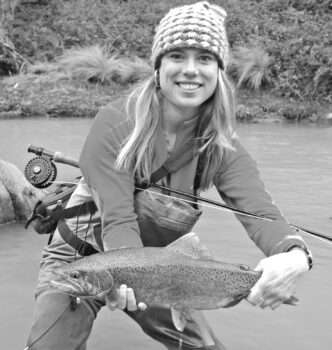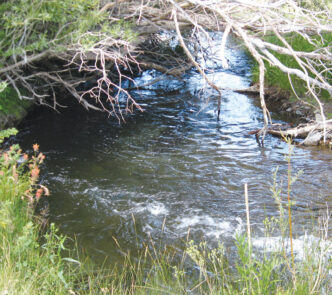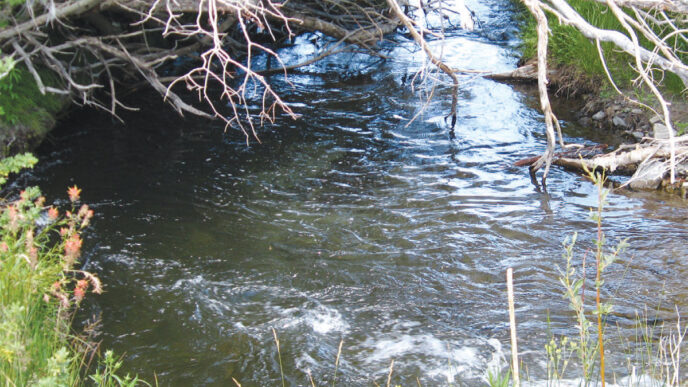It would be the biggest dam-removal project in California’s history. That’s what representatives of fishing groups, farmers, utilities, Indian tribes, and others are saying of a proposal to remove four dams from the Klamath River, potentially opening up 420 miles of habitat in the river and feeder streams for anadromous salmon and steelhead.
The U.S. Department of the Interior recently released the final environmental impact statement (EIS) for its plan to remove the Iron Gate, Copco 1, and Copco 2 Dams north of Yreka in Siskiyou County in California and the J. C. Boyle Dam south of Klamath Falls in Oregon. The EIS is available at http://www.klamathrestoration.gov.
In addition to employing some forty-six hundred people during the anticipated 15 years of dam-removal and restoration work, the $1 billion project would result in an 81 percent increase in habitat for steelhead trout and chinook and coho salmon, according to the EIS. “The report represents the most comprehensive scientific, engineering, and environmental evaluation of facilities removal ever undertaken in the Klamath Basin,” Ken Salazar told the San Francisco Chronicle. Salazar gave preliminary approval to the EIS before leaving office as the secretary of the interior. Final approval for the plan and EIS will be one of the first duties of the incoming interior secretary, Sally Jewell, a former executive for Recreation Equipment Incorporated, better known as REI.
The Klamath, which flows for more than 250 miles from Oregon to the Pacific and drains over twelve thousand square miles of mountains, forests, and marshlands, has the third-largest runs of salmon in the lower 48 states, behind the Columbia and Sacramento Rivers. Several runs of salmon and steelhead that rely on the river are on the state or federal endangered species lists.
Talks over the future of the Klamath had been grinding along for 10 years, but were energized in 2002 after a federally ordered flow change resulted in the death of thirty thousand to sixty thousand salmon in the river.
Three years ago, 42 parties signed an agreement that laid out the process for the dams to be removed, beginning in 2020. The owner of the dams, the PacificCorp utility company, signed on as one of the parties. A companion agreement that would appropriate $800 million over 15 years for habitat restoration was also approved by the parties.
“Dozens of groups came together and, despite their very different perspectives, were able to hammer out these agreements,” said Curtis Knight, conservation director for California Trout. “Congress must now do its part to turn this proposed local solution into reality.” Congress must ratify the agreements, but there has been a reluctance to approve a large expenditure of funds for the project. CalTrout and other groups have launched a letter-writing campaign to urge lawmakers to support the Klamath’s restoration.
In addition to congressional approval of the funding, the agreements face a few more hurdles before removal of the dams can take place. The proposal is opposed by some one hundred owners of lakefront homes, who would likely see their property values drop when the lakes behind the dams are drained. The conservation group Oregon Wild has filed a 60-day notice of intent to sue the government because the agreement’s lowering of guaranteed flows intended to protect salmon in the Klamath was illegally imposed. Newly elected conservative members of the Klamath County Board of Supervisors have voted to get out of the agreement, according to the Associated Press. And PacificCorp would need to charge its ratepayers in Oregon and California an extra two percent on their monthly electric bills to pay the first $200 million of the project, which itself provokes opposition.
CalTrout and the other groups supporting the agreement have been asking congressional leaders to hold hearings on the Klamath issues, but none have been scheduled. “If legislators lack the will to hold hearings on the Klamath agreements and shepherd the legislation through Congress,” said CalTrout in a briefing paper on the issue, “then they should offer a realistic alternative to the economic and biological hardship that otherwise lies ahead.”
The economic hardships to which the briefing paper is referring include those that would result from long-run loss of water for farmers and ranchers in the Klamath Basin, an increase in electricity costs for seventy thousand utility customers, loss of steelhead for sport anglers, collapse of the commercial salmon fishing industry, and uncertainty caused by the cumbersome Federal Energy Regulatory Commission dam-licensing process.
Some federal politicians are beginning to rally around the agreements. “The scientific and common sense conclusion is clear,” California congressman Jared Huffman said in the San Francisco Chronicle. “We should tear down these dams.”
Before the dams can come down, Huffman and other leaders must somehow overcome opposition in Congress, a position that has prevented hearings from being held and endorsement of the agreements. As quoted in an Associated Press story, Jeff Mitchell, a member of the Klamath Tribes tribal council, said that the community was “heading for a train wreck” if action isn’t taken quickly.
Contentious Delta Fish Debate Goes Public
“Whiskey is for drinking, and water is for fighting over,” said Mark Twain. Today, he might add “especially Delta water.” There certainly will be plenty of fighting ahead over the water in the Sacramento–San Joaquin River Delta. Battle lines now have been publicly drawn in the debate over a draft long-term water plan, with its proposal to build two 35-mile tunnels to divert water around the Delta.
The tunnels would contain pipes — each 40 feet in diameter, with the capacity of moving 15,000 cubic feet of water per second — that would take water from the Sacramento River from Clarksburg, just below Sacramento, down to the existing state and federal pumps near Tracy.
The plan proposes to divert 9,000 cubic feet per second through the pipes. The average flow in the Sacramento River is around 30,000 cfs, according to U.S. Geological Survey gauging-station data, but can exceed 40,000 cfs in February and decrease to as low as 12,000 cfs in October.
A preliminary draft of several chapters from Bay Delta Conservation Plan (BDCP), which sets priorities for the 738,239-acre Delta for the next 50 years, was recently released by the California Department of Water Resources in order to attract comments from the many interests, including anglers, environmentalists, ranchers, farmers, and others across the state, who benefit from the Delta or use water that flows through it. In addition, the plan includes proposed flow and water-storage regimes for water bodies as far north as Lake Shasta and the Trinity River. At an April hearing following the release of the draft text, competing sides went public, staking out their turf with testimony and lengthy position papers over the state’s plan to protect endangered fish in the 1,315-square-mile Delta and secure drinking water for some 35 million residents.
At the afternoon-long hearing, the draft attracted mostly critical comments, many from elected officials in Congress. “The plan is an outdated and destructive plumbing system. It does not create any new water, nor does it provide the water and the ecological protection that the Golden State must have,” said Representative John Garamendi, a rancher who lives in the Delta community of Walnut Grove. “Moving forward could cause permanent harm to wildlife and devastate farmers, fishers, and small-business owners who depend on the Delta for their livelihood,” said Rep. Mike Thompson.
“To solve California’s water situation, we must find an approach that doesn’t take the problems of one half of the state and lay them at the feet of the other half,” said Representative Doris Matsui.
There was disagreement over nearly all aspects of the plan, including the price tag, which the state claims will total $23 billion, but environmentalists say will run as high as twice that amount. And according to the Sacramento Bee, the state’s estimate does not include $265 million to reroute three highways around proposed new pumping facilities.
There was no opposition to the draft plan’s goal of protecting and restoring 145,000 acres of aquatic and terrestrial habitat. However, most of the other provisions of the preliminary draft were opposed by fishery-conservation groups, including the California Sportfishing Protection Alliance, which is funded by many of the state’s fly-fishing clubs.
A full draft of the Delta plan and environmental analysis will be released for public review and be the subject of public hearings in July. The final draft will be released in January 2014, and final adoption is scheduled for April 2014.
Groups Advocate Using Forestry Funds for Fish
Conservation groups are patrolling the halls of the state legislature, advocating that a new source of forestry funds be allowed to be used for fish-restoration projects. The new funds come from Assembly Bill 1492, passed in last year’s legislative session and signed by the governor, which authorized the state to charge a 1 percent tax on all forest products sold in California. The goal of the measure was to provide an ongoing source of some $1.5 million in funds annually for the California Department of Fish and Wildlife to review the impact of timber harvest plans on wildlife.
The groups are lobbying for passage of Assembly Bill 875, which was introduced by Assembly Member Wes Chesbro and would add salmon and anadromous trout to the list of species that qualify for use of the funds for habitat restoration.
If passed, AB-875 could be used to pay for fish and wildlife pilot restoration projects, which would have to be completed by January 1, 2017. The measure is pending in the Assembly Natural Resources Committee. To support or comment on the bill, write to Chesbro at Room 2141, State Capitol, Sacramento, California, 95814, or send an e-mail to Assemblymember.Chesbro@assembly.ca.gov.
Merced Advocates Oppose Wild River Status Change
The advocacy group Friends of the River is opposing congressional legislation that would remove a small section of the Merced River from protection under the national Wild and Scenic River Program in order to build a reservoir. Friends of the River has instructed its members to oppose House Resolution 934, which is sponsored by Representative Tom McClintock, which would remove a protected section of the river to allow the McClure Reservoir to be built. If approved by Congress, the action would represent the first time that a free-flowing river has been removed from the protective program. For more information on the issue, see http://friendsoftheriver.org, or send an e-mail to Ron Stork at rstork@friendsoftheriver.org.
Citizen Monitoring Leads to Revised Eel River Management
Citizens do matter, especially for monitoring on the Eel River in Northern California. The Eel River Recovery Project enlisted the help of citizens to monitor the river, which suffers from reduced flows and water-quality woes.
Residents are concerned about the decline of the river. The Eel River drainage is the center of extensive marijuana-growing operations, and results of citizen monitoring of its flows included in a 2012 monitoring report showed that river flows have diminished since 1996, when medical marijuana was legalized in California. In addition, the report concluded that three major tributaries to the Eel — Outlet, Tomki, and Ten Mile Creeks — have been dry in the late summer, which was not their historical condition prior to 1996. These creeks were major producers of salmon and steelhead and provide water to maintain the ecological balance in the main-stem Eel River. The report recommended that Ten Mile Creek be targeted for improvement in order to help the recovery of salmon and steelhead. In addition, other recovery strategies are being developed, based on review of the data from citizen monitoring.
Spring Events for Trout Groups
There is more to trout fishing in the spring than trout fishing. Part of being a good trout angler is to take part in conservation, education, and advocacy activities, and there are a number of them available: On May 10, beginning at 6:00 P.M., California Trout will hold its Fourteenth Annual Gala Benefit and Auction at the Four Seasons Hotel, 757 Market Street, San Francisco. Tickets for the event range from $300 to $1,500. Information and tickets are available at http://caltrout.org/trout-camp-2013.
On May 11 at the San Joaquin Hatchery, 17372 Brook Trout Drive, Friant, California, the California Department of Fish and Wildlife will host a free Trout Fest, an event for children that includes casting, rigging, knot tying, fly tying, trout tasting, fish printing, face painting, and more. The department will hold another such event on June 29 at the Hot Creek Hatchery, 121 Hot Creek Hatchery Road, Mammoth Lakes, California. Both events run from 10:00 A.M. to 2:00 P.M.
On June 7 through 9, the Sierra Nevada Alliance, an umbrella organization of regional conservation groups, is hosting a fly-fishing weekend at Sorensen’s Resort in Hope Valley. This introductory seminar will cover the varieties of flies and their uses, equipment options, trout and their habitats, casting technique, stream strategies, and landing and releasing. For more information, visit
http://sierranevadaalliance.givezooks.com/events/fly-fishingweekend-in-hope-valley.













